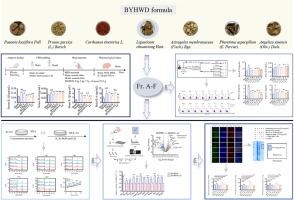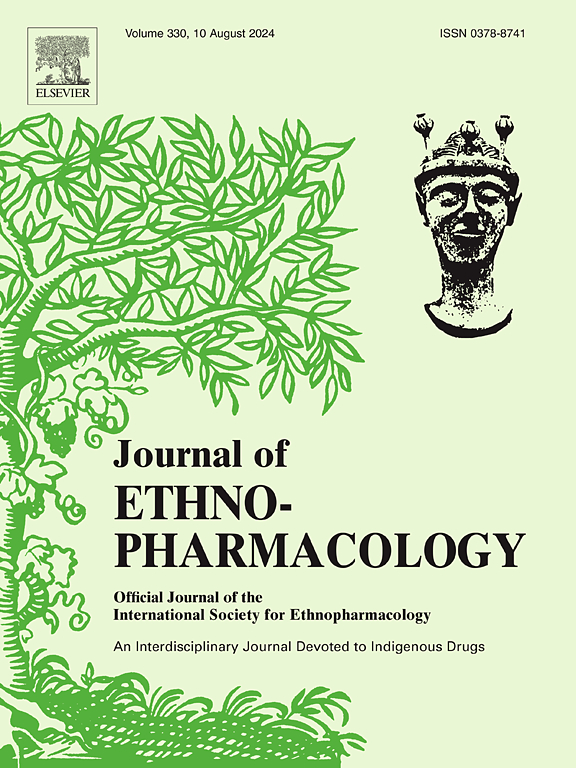川芎阴经药性特征的厘清。通过增强治疗效果,引导和靶向性。
IF 5.4
2区 医学
Q1 CHEMISTRY, MEDICINAL
引用次数: 0
摘要
民族药理学相关性:川芎。(LC)是补阳还五汤(BYHWD)中的阴经药,具有“上导药”的功能,加强BYHWD的治疗效果。然而,LC如何引导其他药物靶向器官尚不清楚,也没有研究阐明LC的阴经药性(YJMP)的物质基础。研究目的:本研究的主要目的是通过分子生物学方法阐明LC的YJMP的物质基础,并探讨其相关的潜在机制。材料与方法:建立大鼠脑缺血再灌注损伤模型。在系统表征BYHWD化学成分的基础上,筛选出BYHWD的最佳有效剂量,并比较BYHWD与[BYHWD- lc]的疗效差异。同时,利用分子生物学等技术对“阴经”与羟基红花黄A (HYA)偶联的增强疗效(PTE)、导向性和靶向性进行了评价。结果:BYHWD的最佳有效剂量为2倍剂量,且LC可增强其治疗效果。PTE实验结果表明,A-C片段(Fr.A、Fr.B和Fr.C)在体内可增强[BYHWD-LC]的治疗效果,而Fr.A和Fr.C在体外可增强HYA的治疗效果。诱导实验结果表明,Fr.C可增强PC12细胞HYA的通透性。蛋白质组学研究显示,BYHWD和[BYHWD- lc]之间存在与内质网(ER)-高尔基体和突触囊泡循环相关的差异表达蛋白。靶向性实验进一步证实Fr.C增加HYA通透性,激活er -高尔基体,并鉴定与突触囊泡循环相关的Endophilin-A1蛋白为介导Fr.C脑靶向性的核心亲和靶点。本研究在基于PTE、导向性和靶向性的评价体系中,首次确定了frc为LC的YJMP的物质基础,并明确了其潜在机制可能与激活er -高尔基转运系统和促进突触囊泡循环有关。本文章由计算机程序翻译,如有差异,请以英文原文为准。

Clarification of the Yin-Jing medicinal property characteristic of Ligusticum chuanxiong Hort. via potentiating therapeutic effect, guidance and targetability
Ethnic pharmacological relevance
Ligusticum chuanxiong Hort. (LC) is a Yin-Jing medicine in Buyang Huanwu decoction (BYHWD), carries the function of a “guiding the drug upward” to strengthen the treatment outcomes of BYHWD. However, how LC guides other drugs to target organs remains unclear, and no studies have clarified the material basis of LC's Yin-Jing medicinal properties (YJMP).
Aim of the study
The primary objective of this investigation is to clarify the material basis of LC's YJMP via molecular biology methods and explore its related potential mechanisms.
Materials and methods
This investigation developed a rat-based model of cerebral ischemia-reperfusion injury (CIRI). Based on the systematic characterization of the chemical composition of BYHWD, the optimal effective dose of BYHWD was screened out, and the therapeutic effect differences between BYHWD and [BYHWD-LC] were compared. Meanwhile, the potentiating therapeutic effects (PTE), guidance and targetability assays were employed to assess “Yin-Jing” functions by coupled with hydroxysafflor yellow A (HYA) using molecular biology techniques, etc.
Results
The optimum efficacious dosage of BYHWD is twice the dose, and the LC can potentiate the therapeutic effect of [BYHWD-LC]. The findings from the PTE experiments demonstrated that fragments A-C (Fr.A, Fr.B and Fr.C) could potentiate the therapeutic effect of [BYHWD-LC] in vivo, while Fr.A and Fr.C could enhance the therapeutic effect of HYA in vitro. The results of the guidance tests indicated that Fr.C enhanced the permeability of HYA in PC12 cells. Proteomic revealed that there are differentially expressed proteins related to endoplasmic reticulum (ER)-Golgi and synaptic vesicle cycling between BYHWD and [BYHWD-LC]. Targetability experiments further confirmed that Fr.C increased the permeability of HYA and activated the ER-Golgi, and identified the Endophilin-A1 protein (related to synaptic vesicle cycling) as the core affinity target mediating the brain targetability of Fr.C.
Conclusions
In this study, within the evaluation system based on PTE, guidance and targetability, Fr.C was first identified as the material basis underlying LC's YJMP, and clarified that the potential mechanism may be related to the activation of the ER-Golgi transport system and the promotion of synaptic vesicle cycling.
求助全文
通过发布文献求助,成功后即可免费获取论文全文。
去求助
来源期刊

Journal of ethnopharmacology
医学-全科医学与补充医学
CiteScore
10.30
自引率
5.60%
发文量
967
审稿时长
77 days
期刊介绍:
The Journal of Ethnopharmacology is dedicated to the exchange of information and understandings about people''s use of plants, fungi, animals, microorganisms and minerals and their biological and pharmacological effects based on the principles established through international conventions. Early people confronted with illness and disease, discovered a wealth of useful therapeutic agents in the plant and animal kingdoms. The empirical knowledge of these medicinal substances and their toxic potential was passed on by oral tradition and sometimes recorded in herbals and other texts on materia medica. Many valuable drugs of today (e.g., atropine, ephedrine, tubocurarine, digoxin, reserpine) came into use through the study of indigenous remedies. Chemists continue to use plant-derived drugs (e.g., morphine, taxol, physostigmine, quinidine, emetine) as prototypes in their attempts to develop more effective and less toxic medicinals.
 求助内容:
求助内容: 应助结果提醒方式:
应助结果提醒方式:


